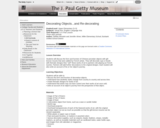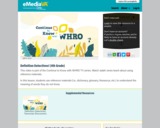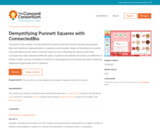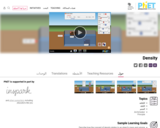
third grade lesson connecting coding skills with decomposing multi step math problems
- Subject:
- Algorithms and Programming
- Material Type:
- Activity/Lab
- Author:
- ANGELA PATTON
- Date Added:
- 12/21/2021

third grade lesson connecting coding skills with decomposing multi step math problems

Students will apply problem solving skills to decompose a multi-step word problem into smaller chunks. Students will color-code information to determine “step 1” and “step 2” and organize their information and work into a chart. Students will have the opportunity to extend their skills with more challenging problems or be remediated by the teacher.

Students will take the role of a PSA (Public Service Announcement) team, creating a visual presentation of a problem using thinking maps/graphic organizers, and presenting potential research-based solutions for a problem. Students will have three different problems to choose from (Ocean plastic, head injuries in football, and too much testing in schools), each with a scaffolded set of resources for them to choose from in order to aid in research and information gathering.

Students will make tasks (party planning, building a tower, writing a story) easier by breaking the problems down into manageable chunks. Students will also break down words into root words and affixes.

In this lesson, students will be introduced to the idea of decomposition. Specifically the lesson caters to math word problems, but could be easily modified to any subject (as found in the modificaitons section of the lesson plan). Students will engage with each other and the vocab to work through an easy process to decompose word problems into manaeagable pieces as a strategy to solve. All activities are low prep and can be modified to your needs. This can be a stand alone lesson or expanded by using Part 2 and Part 3 to deepen understanding through coding activities.

This lesson expands upon the ideas of decomposition by using GameChangineer to incorporate commands to create a coded mini game from decomposing word problems. Students will assist the teacher in this guided lesson on how to create commands and use the website before engaing independently in Part 3. Activities are low prep with modifications included, but do require organized planning to implement effectively. If you have not done a lesson on decomposition, it is suggested you use Part 1 to help student's gain the necessary understandings of the processes used in this lesson.

This is the final part of an extended lesson on decomposition. Students will create a word problem to decompose and then use GameChangineer to create a mini game that is reflective of the word problem and its solution. Students will be using the plan, design, and review process thourhgout their creations. A rubric and self reflection tool for the final products are included. Activities are low prep with modifications included, but do require organized planning to implement effectively. If you have not done a lesson on decomposition, it is suggested you use Part 1 to help student's gain the necessary understandings of the processes used in this lesson. If you have not done a lesson on writing commands and using GameChangineer, it is suggested you use Part 2 before implementing this independent activity.

Students will discuss the form and function of Chinese porcelain with gilt-bronze mounts that were added by French artists. They will decorate cups or bowls with thematic designs then "sell" these works to partners role-playing as French tourists. Partners will add decorations to the original designs. Each student will also write an account of his or her object's journey.

Applying deductive thinkingMathematics Instructional Plans (MIPs) help teachers align instruction with the 2016 Mathematics Standards of Learning (SOL) by providing examples of how the knowledge, skills and processes found in the SOL and curriculum framework can be presented to students in the classroom.

In this sequence of lessons, students explore the deer mouse and its fur color and how it has evolved over time in different habitats. Students engage in the practices of science using a series of interactive computer simulations to create model(s) of evolutionary change across levels of biological organization, from molecules and cells to organisms and populations. NOTE: This sequence is designed specifically for use on touchscreen devices.

Americans elect a president through the state-by-state mechanism of the Electoral College rather than direct nationwide popular vote. Today, all but two states award all of their electoral votes to the statewide winner.
This is a "remix" of a previous resource: https://goopenva.org/courses/a-defense-of-the-electoral-college
It has been remixed to add a visual map and additional student questions.

Sequencing is a skill that is important in many content areas as well as computer science. After listening to a well known story such as The 3 Little Pigs or The 3 Bears and Goldilocks, students will demonstrate an understanding of sequence by drawing the beginning, middle and end of the story and labeling it with b for beginning, m for middle, and e for ending.

This video is part of the Continue to Know with WHRO TV series. Watch Jadah Jones teach about using reference materials.

Explore the effect of an electric field on the electron distribution of an atom.

This interactive lesson teaches middle school students about how information is delivered via the internet. Students will review/ be introduced to vocabulary words, gain an understanding of packets and servers, and be challenged with different internet connectivity (Wi-Fi, cable, DSL, and Fiber Optic) as they work together as a team to deliver a message to another IP address.
This lesson has been slightly adapted from the original version from Code.org. All the links and copyright information are included in the lesson. The teacher is able to use the original or the premade materials from this document.
Have fun!

The goal of this exercise is to examine the relationship between demographic characteristics and different forms of civic participation. Crosstabulation will be used.

The goal of this activity is to demystify the science behind Punnett Squares and explore data and statistical representations in genetics and heredity. Begin by breeding two parent mice and observe the ratios in the pie chart as more offspring are bred in each litter. Compare the ratios between different pairs of parents and identify how they are different or similar. Finally, use the simulation controls to show gametes and reveal how each offspring obtained its genotype from its parents.

Students will review denotation and connotation. The teacher will provide examples. Students will then work independently or in pairs to replace the underlined words in the given sentences with synonyms that have either a positive connotation or a negative connotation. Students will share their answers with the class.

Explore how plate interactions are the result of different densities.

Why do objects like wood float in water? Does it depend on size? Create a custom object to explore the effects of mass and volume on density. Can you discover the relationship? Use the scale to measure the mass of an object, then hold the object under water to measure its volume. Can you identify all the mystery objects?